Characteristics
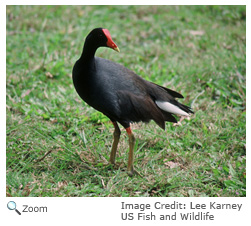 The common moorhen is a meduim-sized member of the rail family found in aquatic environments. It is 12-15 inches in length and has a wingspan of a little under two feet. It has gray-black feathers and a red bill with a yellow tip. It has white stripes on its sides. It has long chicken-like toes that help it walk on the top of floating vegetation and the mud. Males and females are similar, but males are a little larger. The common moorhen is a meduim-sized member of the rail family found in aquatic environments. It is 12-15 inches in length and has a wingspan of a little under two feet. It has gray-black feathers and a red bill with a yellow tip. It has white stripes on its sides. It has long chicken-like toes that help it walk on the top of floating vegetation and the mud. Males and females are similar, but males are a little larger.
Range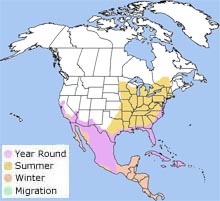 In the western United States, the common moorhen breeds in California, New Mexico, Nevada and Arizona. In the eastern United States and Canada, it breeds from Minnesota to New Brunswick and south to the Gulf Coast and Florida. In the United States the moorhen winters in California and Arizona, along the Gulf Coast and on the east coast from Virginia to Florida. It is also found in South America, Europe, and parts of Asia and Africa. In the western United States, the common moorhen breeds in California, New Mexico, Nevada and Arizona. In the eastern United States and Canada, it breeds from Minnesota to New Brunswick and south to the Gulf Coast and Florida. In the United States the moorhen winters in California and Arizona, along the Gulf Coast and on the east coast from Virginia to Florida. It is also found in South America, Europe, and parts of Asia and Africa.
Habitat
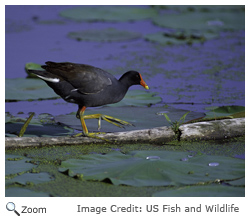 The common moorhen lives in freshwater and brackish marshes, lakes, canals and ponds with cattails and other aquatic vegetation. The common moorhen lives in freshwater and brackish marshes, lakes, canals and ponds with cattails and other aquatic vegetation. |
|
Diet
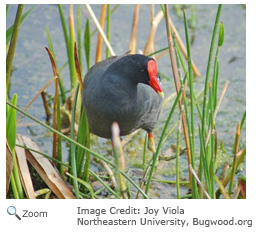 The common moorhen is omnivorous and feeds while walking on plants or while floating on the water. It swims across the water to scoop up floating seeds and other materials from plants floating on the surface of the water. It also dives to gather the seeds, leaves and roots of aquatic plants. On land it walks with a high-stepping gait and pecks at the ground like a chicken. It also eats algae, small fish, tadpoles, insects, berries, grass, snails, insects and worms. The common moorhen is omnivorous and feeds while walking on plants or while floating on the water. It swims across the water to scoop up floating seeds and other materials from plants floating on the surface of the water. It also dives to gather the seeds, leaves and roots of aquatic plants. On land it walks with a high-stepping gait and pecks at the ground like a chicken. It also eats algae, small fish, tadpoles, insects, berries, grass, snails, insects and worms.
Life Cycle
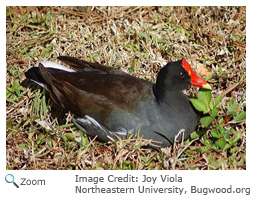 The male moorhen courts the female by bringing her water weeds and fanning out his tail. The males and the female form a monogamous pair. The pair builds several nests in their territory.
The nest is bowl-shaped and made of twigs, cattail and bulrush stems and grass and sedges. It is lined with leaves and other plants. The nest is built within a few feet of the water and sometimes it is even built on floating plants in the water. The moorhen may pull down plants growing around the nest to provide a protective cover for the nest. Because they are so close to the water, moorhen nests are often lost to flooding. The male moorhen courts the female by bringing her water weeds and fanning out his tail. The males and the female form a monogamous pair. The pair builds several nests in their territory.
The nest is bowl-shaped and made of twigs, cattail and bulrush stems and grass and sedges. It is lined with leaves and other plants. The nest is built within a few feet of the water and sometimes it is even built on floating plants in the water. The moorhen may pull down plants growing around the nest to provide a protective cover for the nest. Because they are so close to the water, moorhen nests are often lost to flooding.
The female common moorhen lays four to twelve eggs at a rate of one egg per day. The eggs hatch in 17-22 days. The chicks are
precocial and will leave the nest and feed themselves within a few days of birth. Once all the chicks leave the nest, the moorhens use the extra nests to sleep in at night. Both parents care for the chicks. They chicks fledge in about five to seven weeks.
The mating pair may raise more than one brood in a season, using the same nests.
Behavior
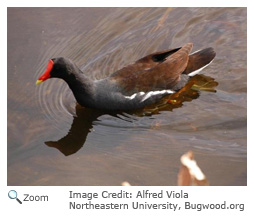 When the common moorhen swims, it bobs its head back and forth. It is a better swimmer and walker than flier, although in some parts of its range it does migrate long distances! When the common moorhen swims, it bobs its head back and forth. It is a better swimmer and walker than flier, although in some parts of its range it does migrate long distances!
|